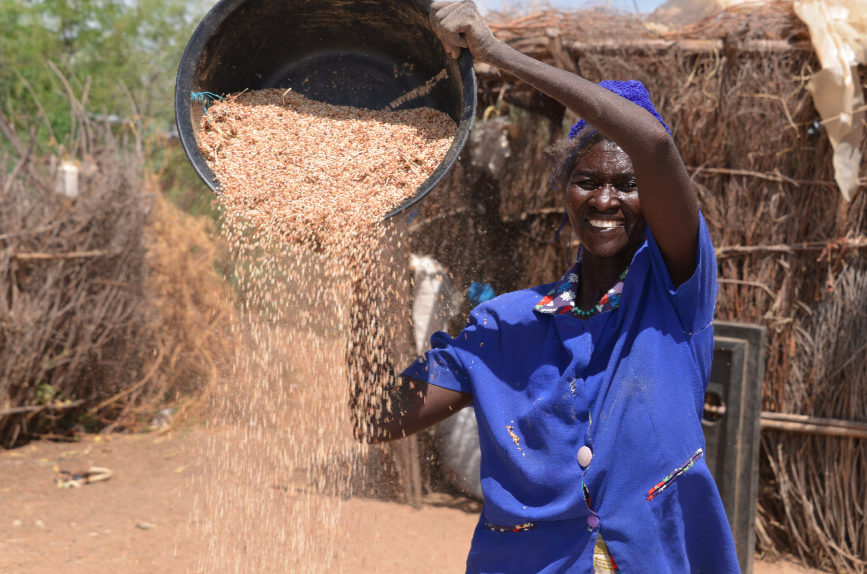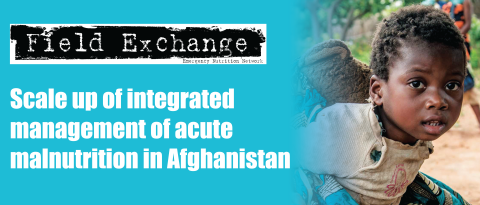Humanitarian-development nexus: nutrition policy and programming in Kenya
By Carmel Dolan and Jeremy Shoham
Carmel Dolan is an ENN Technical Director, co-editor of the ENN publication Nutrition Exchange, and co-lead on ENN’s knowledge management support to the Scaling Up Nutrition (SUN) Movement.
Jeremy Shoham is an ENN Technical Director, co-editor of Field Exchange, and co-lead on ENN’s knowledge management support to the SUN Movement.
This article provides a summary of a detailed case study carried out during a field visit to Kenya by ENN 1. ENN would like to acknowledge Irish Aid for funding this work and thank all those interviewed for their time.
Location: Kenya
What we know: There is global commitment to strengthen the linkages between humanitarian and development programming.
What this article adds: A recent ENN field-based case study in Kenya examined experiences of the humanitarian development nexus (HDN) through a nutrition-specific and nutrition-sensitive programming and policy lens. Kenya is on track to meet World Health Assembly nutrition targets, largely due to successful scale-up of high-impact nutrition interventions, particularly integrated management of acute malnutrition and a surge model for treatment in Kenya’s arid and semi-arid counties. Improved risk reduction and quicker, more effective response evidenced in the 2016/17 drought response are attributable to national government growth; stronger government leadership; the Ending Drought Emergency framework; devolution; strengthened health systems; and scalable social protection systems for the most vulnerable. Ongoing challenges include limited community mobilisation in the ‘surge’ model; variation in multi-sector collective outcomes and priority setting/contingency planning at devolved level; weak influence of nutrition in shaping high-level frameworks, design of social protection programmes; and tensions between nutrition-specific and nutrition-sensitive investments. The Scaling Up Nutrition Movement has not yet given rise to a multi-sector platform that gains nutrition leverage and visibility. Action is needed at global level to ensure nutrition joins the discourse around HDN.
Among the ten commitments in the Grand Bargain that were articulated during the World Humanitarian Summit in Istanbul in 2016, was “the need to strengthen linkages between humanitarian and development programming”. The consensus on this has grown with the realisation that an estimated 70 to 80 per cent of humanitarian programmes take place in protracted emergencies, where short-term humanitarian programming is inappropriate. Taking up this mantle, the United Nations Office for Coordinating Humanitarian Affairs developed the New Way of Working (NWW) framework, which is predicated on four pillars: joined up analysis of acute and long-term needs; joint humanitarian and development partner planning with collective outcomes; joint leadership and coordination, building on opportunities and comparative advantage; and financing modalities to support collective outcomes. Organisations like the World Food Programme (WFP) are now shifting their programming from short-term emergency response plans to a country strategy model with longer-term financing windows of three to five years and the inclusion of childhood stunting reduction as a declared goal. The Global Nutrition Cluster (GNC) is also turning its attention to an integrated model of programming, whereby integration is not just promoted between the clusters/sectors but also with longer-term government and civil society structures and capacity strengthening.
ENN aims to capture humanitarian development nexus (HDN)-related experiences in the coming years and disseminate examples of what is working. This article summarises the main findings of the first of several planned case studies. Research was carried out during a short visit to Kenya in 2017 using a nutrition-specific and nutrition-sensitive programming and policy lens and includes a brief case example of Wajir county.
 Nutrition policy in Kenya
Nutrition policy in Kenya
Kenya’s economy is growing; it has a 2030 development vision to reach middle-income country status and its humanitarian system architecture has largely been overtaken by greater government investment in resilience building, social protection programmes and early response systems.
Kenya is on track to meet many of the World Health Assembly (WHA) nutrition targets, attributed to its success in scaling up high-impact nutrition interventions (HINIs) over the past decade. A key element of this is the integrated management of acute malnutrition (IMAM), which has been increasingly integrated into the health system. In addition, a surge model allows for the scaling up of treatment in a number of the vulnerable arid and semi-arid lands (ASAL) in response to crisis. In recent years, the Government of Kenya (GoK) has established social protection programmes (SPPs), including the Hunger Safety Net Programme (HSNP) in four ASAL counties (65 per cent GoK-funded) and a cash transfer (CT) programme for up to half a million people. There are also GoK-funded SPPs for the elderly, severely disabled, and orphans and vulnerable children, as well as an asset-creation CT programme implemented by the WFP.
Resilience programming has become a major component of Kenya’s national Mid-Term Development Plan (MTDP) and is a key pillar of the Ending Drought Emergencies (EDE) framework. Central to the EDE is the strengthening of systems that allow earlier responses to threats before a full-scale emergency arises, including diversification of livelihoods in the ASAL counties and risk anticipation. This has largely replaced the need for more traditional humanitarian response in Kenya. The National Drought Management Authority (NDMA), which rolls out the EDE, straddles humanitarian and development programming and is devolved to the 23 ASAL counties. Nutrition is a cross-cutting concern and stunting is one of the key indicators for monitoring EDE progress. Within government, the mandate for nutrition policy development, planning and coordination resides with the nutrition unit of the Ministry of Health (MoH). In spite of the excellent work done by the unit over many years, it maintains a somewhat marginalised position within government. A multi-sector nutrition platform (MSNP) is lacking; therefore cross-sector coordination of nutrition-specific and nutrition-sensitive programming is limited.
Drought response
The response to the 2011 drought that affected large parts of Kenya, particularly the 23 ASAL counties, was characterised as late, poorly coordinated, with low levels of government investment and leadership, little attention to drought resilience building, and high levels of both acute malnutrition and child mortality. In contrast, the response to the ongoing 2016/17 drought started earlier and was more appropriate; the current drought has seen high levels of global acute malnutrition (GAM) but lower mortality. This is possibly to do with lower levels of severe acute malnutrition (SAM) due to scale-up of the integrated management of acute malnutrition (IMAM) and greater resilience to food insecurity this time around. In general, the 2016/17 drought has demonstrated progress in how Kenya’s systems have become orientated to reduce risk and respond more quickly and effectively to crisis. Several factors have contributed to this and, taken together, have enabled a considerable degree of strengthened humanitarian and development linkages. Specifically, the following enabling factors have been identified:
- National economic growth Kenya is now classified as a lower middle-income country (LMIC).
- Strong government leadership for the crisis response, with humanitarian partners providing gap filling rather than first-line response and development partners’ investments aligned with national risk-reduction priorities.
- Devolution of government since 2012. In a context of fully devolved government, the role of local government has provided a freedom to manage budgets directly and determine county-level priorities.
- The elaboration and initial implementation of the EDE framework to achieve greater sector and humanitarian-development system linkages.
- Strengthened health systems and establishment of a surge capacity model for the early treatment of wasting.
- Establishment of scalable social protection systems for the most vulnerable (including the HSNP).
Ongoing challenges
Despite Kenya’s substantial progress towards a significantly integrated humanitarian and development capacity, many challenges still need addressing. After many decades of reliance on humanitarian food aid as the main modus operandi in the crisis-prone northern ASAL counties, there has been a shift away from this approach in recent years. This has perhaps prematurely reduced the capacity to deliver food aid, before there is sufficient resilience, risk reduction and development in crisis-prone counties. The IMAM surge programme in Kenya is in many ways an ideal type of programme for resource-poor and vulnerable populations in drought-risk counties; however, community mobilisation and outreach achieved during the ‘surge’ process has not been maintained. Given that SAM coverage levels in Kenya are low, this is a lost opportunity.
Sub-nationally, devolved county structures are a critical enabler to ensure pre-crisis planning, early response and response based on community felt needs. This responsibility has resulted in strengthened local capacity, which obviates the need to wait for a national response or for humanitarian partners to access external funding. To date, counties often don’t have agreed multi-sector collective outcomes and do not all prioritise risk reduction and/or ensure adequate use of early-response contingency funds.
The necessary architecture for HDN is akin to the enablers required for nutrition-specific and nutrition-sensitive scale-up, albeit at a higher level (EDE is enshrined in law). Both have a multi-faceted lens and objectives linked directly to development/economic targets, as well as to mitigation (prevention), early response (such as mass screening to prevent death from severe acute malnutrition) and surge systems (treatment).
In Kenya, nutrition is still not adequately positioned to influence the shape of high-level frameworks, the design of SPPs, CTs and resilience programming, or to advocate for the targeting of the nutritionally vulnerable at the individual, household or geographic levels. Nutrition in terms of the HDN in Kenya is largely limited to implementation of nutrition-specific interventions; i.e. response built on strengthened government systems through high-HINIs and the integrated management of acute malnutrition (IMAM) are not yet resourced to full scale. This is evidenced by the high levels of acute malnutrition in the current ASAL crisis.
The declaration of an emergency brings in more human and financial resources for nutrition-specific surge activities, but typically these are not sustained by subsequent sector/development efforts. Whether nutrition-specific investments build resilience is debateable, although HINIs seem to have an (undefined/non-evidenced) role in Kenya’s progress in reaching some WHA targets.
There is a general tension between the levels of nutrition-specific and nutrition-sensitive investments in Kenya, which in turn reflects an unresolved divide (despite progress) between the humanitarian and development sectors. This plays out in terms of the differing/competing objectives and design considerations, which often ignore nutrition, and in terms of widely differing target populations. Current levels of investment for the nutrition-sensitive sectors in the ASALs cannot reach levels of coverage and geographical convergence needed to see a population level impact on nutrition.
Nutrition in Kenya is not yet an influencer or driver of change, although this is not because of a lack of effort on the part of the nutrition sector. This is a key risk for nutrition generally and in the context of a rapidly evolving HDN agenda, as well as the growth in cash-related and social protection programming. Because nutrition in Kenya is marginalised, HDN, SPP and CT-related objectives at best view nutrition as an outcome indicator (for example; stunting in the case of the Kenya EDE), as opposed to a key design and targeting consideration.
Nutrition is being left behind in the HDN discourse and this is one area that global nutrition leadership must influence; if one hoped-for outcome of HDN is a lowering of the incidence and prevalence of child wasting and stunting, then even greater efforts are needed to get nutrition expertise at the table of the HDN ‘movers and shakers’ at global and country level. In countries like Kenya, a higher-level forum which can influence other sectors across humanitarian and development approaches (such as the HSNP) is needed. The Scaling Up Nutrition (SUN) Movement has not yet given rise to a multi-sector platform to gain nutrition leverage and visibility.
For more information, contact Jeremy Shoham.
Endnotes
1Dolan C. and Shoham, J. (2017) Humanitarian-development nexus: nutrition policy and programming in Kenya https://www.ennonline.net//hdnkenya


